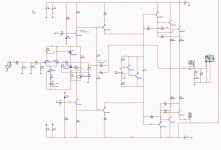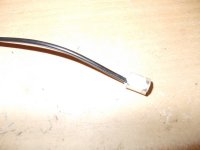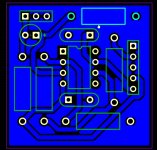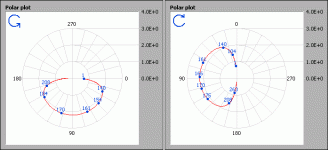Kees,
You make some really nice sounding hybrid amps. Do you have schematics for the second video - sounds wonderful. What speaker is that?
The second video is straight from the amp ouput some milliwatts to pcv input with no speakers connected.
the first video is a new kind of hybrid without cathode follower but a high (100mA) current triode (2.5 mu) in cathode follower configuration give more even harmonics give warm sound with mosfet stage.
here schematic of second hybrid, dc coupled type.
I have also play with the alexanderamp current feedback bipolair version with ring emittor transistors as ouputstage with the discrete Nelsson pass opamp who do nice. see last picture.
But first a couple good speakers like the trynergy or something.
regards
Attachments
Last edited:
Ahh, no speakers direct loopback drive - no wonder it sounds so good. 🙂
Still a great sound though - what is power output capability and can you drive 4 ohm speakers with it?
Still a great sound though - what is power output capability and can you drive 4 ohm speakers with it?
Ahh, no speakers direct loopback drive - no wonder it sounds so good. 🙂
Still a great sound though - what is power output capability and can you drive 4 ohm speakers with it?
As with all amps, the output current capability do decide that, just with mordern mosfets it is no problem, even 2 ohm with paralleling them.
4 ohm goes fine, I get 100 watts easely,, but with trynergy that will blown your ears off.
I have wounte the measurement trouble, it was resonance in the copper tube mike was in.
Yes, use glue to seal tube joints and interface with mic capsule. I thought you have a nice commercially made mike? Is the tube the stand mount holder?
Yes, I measured 92dB with 340 milliwatts at 1m. Very low HD.
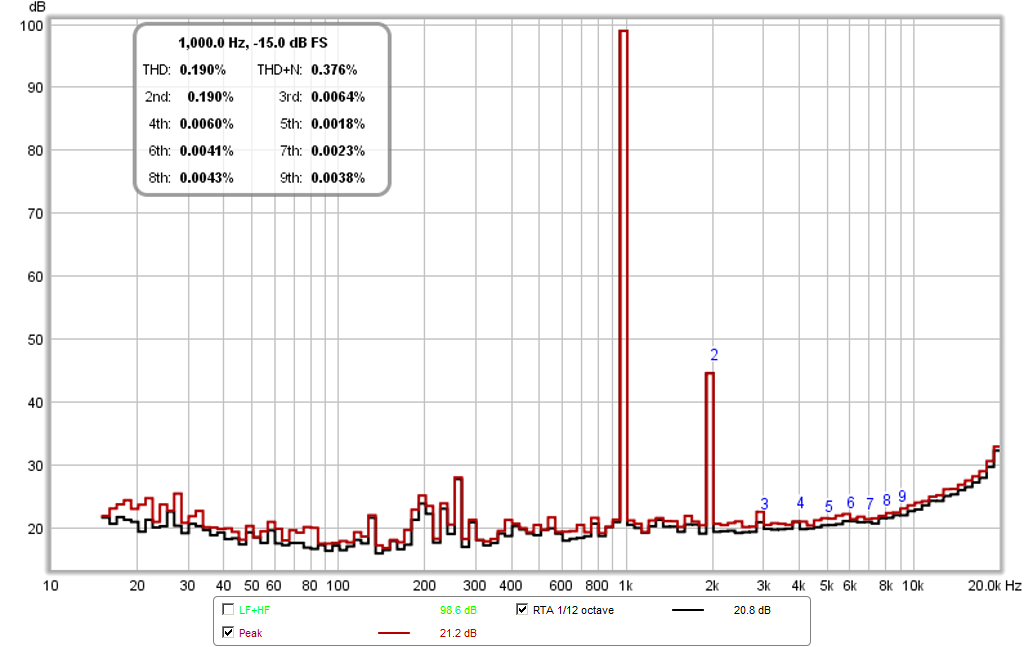
I get 100 watts easely,, but with trynergy that will blown your ears off.
Yes, I measured 92dB with 340 milliwatts at 1m. Very low HD.

Last edited:
The parts are bought, now it is just waiting. In the meantime I am going to sift this thread to find some enclosure / horn dimensions. hopefully I can either print them to scale or load them into cad. I will likely be building the horn out of 1/8" or 1/4" double cld layer. With such thin wood and the right dimensions I can hopefully cut it under the laser.
Yes, use glue to seal tube joints and interface with mic capsule. I thought you have a nice commercially made mike? Is the tube the stand mount holder?
Yes, I measured 92dB with 340 milliwatts at 1m. Very low HD.

You now, I like DIY, so I make it myself, I have the Siegfried Linkwitz mike, I have now gleu mike in rubber tube, and put that in a aluminium tube, that will remove the resonance.
I have now drawn the pcb for the mike amp with a burr brown opamp, RF tight I hope in stereo.
regards.
I have listen a while and have to say the sound of the visaton in the tractrix is very clear, fast and loud. it is worth to examinate more, as the mic is ready I go on with this very interesting approach.
Also please protect your ears, the quality is such high that you can damage them easely, I did measure just 122 dB with it, but it feels like it not that hard because of that warm quality..
regards
Also please protect your ears, the quality is such high that you can damage them easely, I did measure just 122 dB with it, but it feels like it not that hard because of that warm quality..
regards
Last edited:
I agree that the loudness is deceiving since the distortion is so low. We normally use cues from distorted sound to help us determine how loud it is. One good thing with the DIY Linkwitz mic is that if you mod the capsule per instructions - you can measure loud stuff. My mic hits the limit at 114dB. Definitely use ear plugs if putting any more than 500mW into this thing!
Glad you are listening to it - it plays vocals very clearly. I also like the dynamic reserve to go from soft sounds to very loud sounds easily.
Glad you are listening to it - it plays vocals very clearly. I also like the dynamic reserve to go from soft sounds to very loud sounds easily.
If these speakers are set up to be pretty flat on axis down to 100hz. Then can I expect a lot of 100hz - 400hz to wrap around the speakers, and load in the room corners behind them?
Last edited:
Linkwitz mike is also nice for low measurements, because of the source follower now it is very liniair, I have use rubber tube to put mike in and close back airtight.
pcb for amp is just ready, mucho earth on pcb.
regards
pcb for amp is just ready, mucho earth on pcb.
regards
If these speakers are set up to be pretty flat on axis down to 100hz. Then can I expect a lot of 100hz - 400hz to wrap around the speakers, and load in the room corners behind them?
I do not now it this happening with these horns because mid bass is injected. horns are designed for free air, I do not now what happens in a corner where horn dimensions can be smaller, but also I did hear mid bass is not horn loaded and act as normal box, but the most important part of audio is high quality, like 800 to 20.000 Hz.
i do have wrapped sounds with the open baffles, as you now, I have a long horn, there distances are also longer preventing canceling.
There is partial directionality - it's different than a direct radiator on a flat baffle that's for sure. A polar measurement would be good if I can get around to it.
XRK, you've done so much. If you were to get around to doing a polar measurement at some point though it would be much appreciated!
mic is done, in a plastic tube and filled airtight.
Now it wil not resonate anymore.
The horn is fast with the wideband, who is hornloaded, but will de slower below that with the bass units.
I do not now yet how that will sound but I hear from you it is very nice.
And have drawn the pcb in diptrace for the mike with a lot of earth for RF shielding.
still working on it so, get on with it.
Now it wil not resonate anymore.
The horn is fast with the wideband, who is hornloaded, but will de slower below that with the bass units.
I do not now yet how that will sound but I hear from you it is very nice.
And have drawn the pcb in diptrace for the mike with a lot of earth for RF shielding.
still working on it so, get on with it.
Attachments
Last edited:
XRK, you've done so much. If you were to get around to doing a polar measurement at some point though it would be much appreciated!
You can do that like here I believe.
Yes speakers are new for me, still are.
regards
Attachments
Thanks Kees, I'm not exactly sure how to interpret some of those numbers around the wave front. I was thinking of the polar measurement with the pretty colours.
Typically I only provide frequent response curves taken at various angles. There is a package somewhere that can take that and make a nice polar ply like Kees shows. That is basically a plot of SPL vs angle (think of angle like a compass and speaker is at middle ) extent of curve is SPL.
Oh ok, I think I get it. How come the spl is higher on one side than the other? Is that a corner?
Polar response measurements
The mic was 0.5m away and +15 deg above horizontal plane. Data is over 90 deg half angle. First plot is un-gated, second is 4ms gated to remove room reflections. The throat notch anomaly carries through for all angles, the variation between angles appears smooth. The core beam width appears pretty uniform over 60deg full angle and directional below that. I am not sure what I can measure to show that there is directivity at 100Hz over a plain direct radiator.
Un-gated:
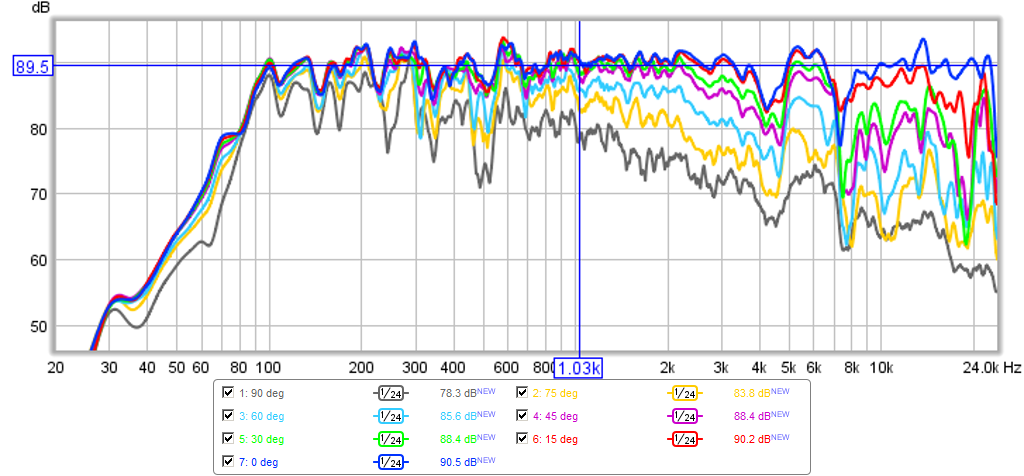
4ms Gate:
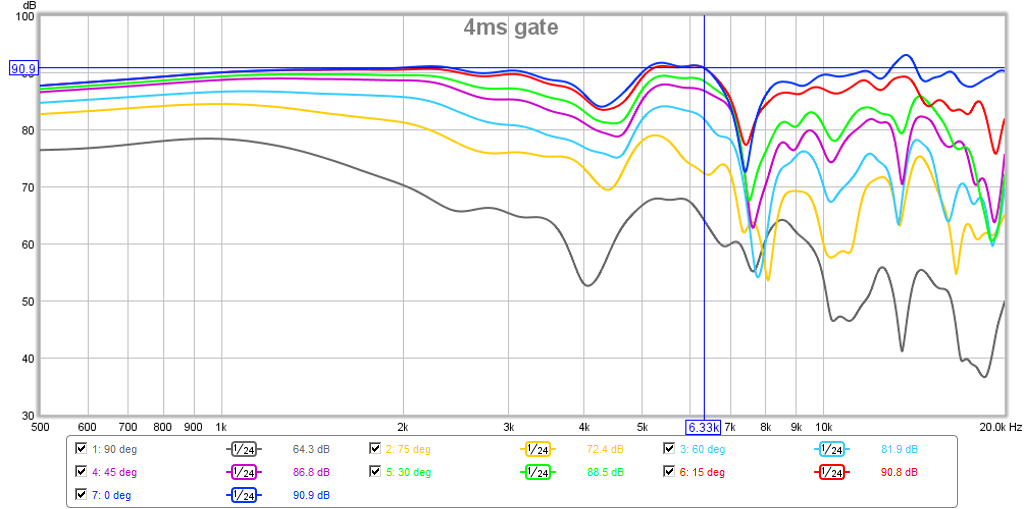
The mic was 0.5m away and +15 deg above horizontal plane. Data is over 90 deg half angle. First plot is un-gated, second is 4ms gated to remove room reflections. The throat notch anomaly carries through for all angles, the variation between angles appears smooth. The core beam width appears pretty uniform over 60deg full angle and directional below that. I am not sure what I can measure to show that there is directivity at 100Hz over a plain direct radiator.
Un-gated:

4ms Gate:

Attachments
- Home
- Loudspeakers
- Multi-Way
- Presenting the Trynergy - a full range tractrix synergy.

